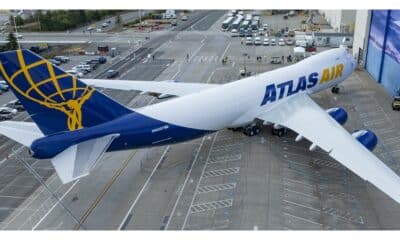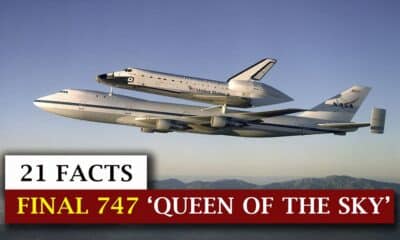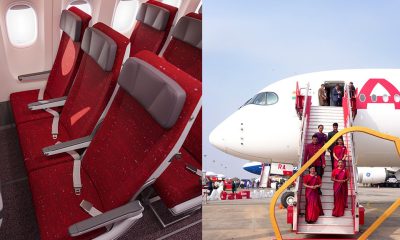Aerospace
Boeing 747 carried 1088 passenger in 1991..!!
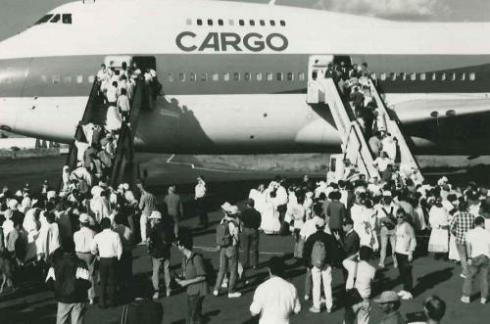
The operation set a world record for single-flight passenger load on May 24, 1991 when an El Al 747 carried 1,122 passengers to Israel (1,087 passengers were registered, but dozens of children hid in their mothers’ robes). “Planners expected to fill the aircraft with 760 passengers. Because the passengers were so light, many more were squeezed in.” Five babies were born aboard the planes
In 24th may 1991 Israel fell into joyous celebration as the Government announced the successful conclusion of an emergency airlift of 14,500 Ethiopian Jews, nearly the entire Jewish population, in just under 36 hours.In order to accommodate as many people as possible, airplanes were stripped of their seats and up to 1088 passengers were boarded on a single plane. Many of the immigrants came with nothing except their clothes and cooking instruments, and were met by ambulances, with 140 frail passengers received medical care on the tarmac. Several pregnant women gave birth on the plane, and they and their babies were rushed to the hospital.

it was difficult to tell who was more joyful — the barefoot Ethiopians who cheered, ululated and bent down to kiss the tarmac as they stepped off the planes, or the Israelis who watched them aglow, marveling at this powerful image showing that their state still holds appeal, even with all its problems.
Role of Israel Defense Forces
In the 1970′s, the Israeli government made the decision to authorize the use of the Israel Defense Forces to enable the immigration of thousands of Jews who were living in Ethiopia, a country that at the time prohibited its citizens from emigrating to Israel. Beginning in 1984, the Israel Defense Forces brought Ethiopian Jews to Israel in three airlift operations, the last of which was Operation Solomon in 1991.
“Operation Solomon truly represents what Zionism is,” said Israel’s air force commander of the time, Maj. Gen. Avihu Ben-Nun. “It demonstrates the purpose for the State of Israel: to provide a home and shelter for Jews around the world who have suffered and were prosecuted merely for bearing the Jewish religion.”
Why Ethiopians was Evacuated ?
In 1991, Ethiopia was experiencing great political instability. The acting government was weak, and the likelihood of it falling to Eritrean rebels was high. Ethiopia’s Jews were in danger. On March 7, Uri Lubrani, an Israeli diplomat, reported on the worsening military situation in Ethiopia, and advised the formulation of “an emergency plan, for the protection and evacuation of the Jewish community.”
Leading up to the operation, $35 million were raised almost overnight in order to pay the Ethiopian government to allow the Jews to leave.
Smooth embark
Just off the taxiway several hundred Ethiopians were seen squatting quietly in the darkness. They were divided into small groups by glow-in-the-dark ropes. Each carried a numbered sticker plastered to the center of his forehead so no one would lose track of his flight.
On signal, each group stood and walked quickly to the plane, carrying nothing but small shopping bags or their babies.
Aircraft Prearrangement
Israelis were no less wondrous at the operational accomplishment of ferrying so many people more than 1,500 miles in 40 flights over so short a time. The air force said 35 civilian and military airplanes, including one Ethiopian airliner, had been used in the operation.
At one point overnight, 28 aircraft were in the air at one time. All of the flights were crammed with passengers, often two or three people to a seat.
But the more common problem was pregnant women. Five babies were born aboard the planes. As each plane arrived at the military airport here, nurses waited at the bottom of the steps to slip sick people into ambulances or the newborn babies into portable incubators. 400 Buses Deployed
“We made history,” said Aryeh Oz, who piloted one El Al 747 cargo plane that carried more than twice as many passengers as it was designed to carry. “It’s the first time that any 747 or any air flying vehicle in the world ever carried 1,087 people. I don’t think it will happen again.”
The airlift proceeded through the night according to a complex schedule involving thousands of people in Israel and Ethiopia, the three dozen aircraft, and more than 400 buses at both ends.
Flight Plan
The pilot did not take off from here until a returning plane had landed, just before 1 A.M. Flight 9, like all the others, followed a route over southern Israel to the Gulf of Aqaba, and then over water all the way to the Ethiopian coast and west to Addis Ababa, arriving at about 4:30 A.M. Even at that hour, the city was brightly lit, and the plane had to circle for 10 minutes before landing, because so many other planes from several countries were trying to crowd into the airport to evacuate their people. An Isolated, Weedy Taxiway
Arrival
Upon arrival, the passengers cheered and rejoiced. The majority of the airlift took place on Sabbath; however, there were no complaints, since Jewish law encourages the violation of Sabbath if it is to save lives
Twenty-nine year old Mukat Abag said, “We didn’t bring any of our clothes, we didn’t bring any of our things, but we are very glad to be here”.
In fact, the Sabbath made the operation easier because all the aircraft and buses that needed to be used were idle. The Israeli government placed the entire operation under total military censorship, and did not lift it until the operation was completed. Even afterwards, it refused to discuss details with other countries due to commitments it has made to the United States and Ethiopian governments.
“We’ve stood up to our obligation and completed the operation bringing all the Jews,” Prime Minister Yitzhak Shamir declared tonight. “It gives us a feeling of strength.”
Source :.jochnowitz.net, wikipedia, idfblog , New York times
Liked It ?
Share with your friends & family.

Aerospace
China Secures Production Certificate for Mass Production of Pilotless eVTOL Aircraft

The first passenger-carrying pilotless electric vertical takeoff and landing (eVTOL) aircraft in the world, the EH216-S, has received the Production Certificate for its eVTOL aircraft from the Civil Aviation Administration of China (CAAC).
This is a significant milestone for EHang Holdings Limited, the leading UAM technology platform company in the world. This outstanding accomplishment is another big step towards mass manufacturing for the eVTOL aircraft and the ensuing commercial operations, building on the ground-breaking acquisition of the Type Certificate and the Standard Airworthiness Certificate for the EH216-S.
The PC is a crucial certificate that the aircraft maker receives from the CAAC, the country’s aviation authority. By obtaining this certificate, EHang has demonstrated that it has set up a quality management system for mass production that satisfies the airworthiness regulation standards set forth by the CAAC, and the company has been given permission to continue producing mass quantities.
It is also a strong guarantee of the calibre of the goods made by EHang. Raw materials, supplier management, manufacturing organisation, production quality control, aircraft pre-delivery test, after-sales repair and maintenance, etc. are all included in the mass production quality management system for the EH216-S.
To ensure that every aircraft and its components that roll off the production line strictly adhere to the approved type design and safety requirements, the system sets clear guidelines and documentation for every step in the production procedure. This ensures comprehensive traceability and safety control.
Aerospace
Four Airbus A380 Superjumbos lined up to be scrapped

In a strategic move aimed at reclaiming valuable resources from the iconic Airbus A380 aircraft, VAS Aero Services and Dr. Peters Group have announced a significant collaboration.
This partnership marks a milestone in aviation logistics and aftermarket services, with four of these colossal planes slated for teardown and redistribution of used serviceable material (USM).
The venture between VAS Aero Services, renowned for its expertise in aircraft dismantlement, and Dr. Peters Group, a prominent Germany-based investment fund management firm, underscores a commitment to sustainable aviation practices. This isn’t their first foray into scrapping A380s; their successful partnership has already seen the dismantlement of these aircraft, making them pioneers in this niche.
Under the agreement, the latest consignment brings the tally to eight A380s entrusted to VAS by Dr. Peters Group. Managing Director Christian Mailly of Dr. Peters Group emphasized the trust placed in VAS, citing their unparalleled capabilities in dismantlement and aftermarket sales network. It’s a strategic move in response to the growing demand for quality USM parts, particularly with the resurgence in reliance on the A380.
Notably, the teardown process will be carried out at various locations, optimizing the positioning of harvested parts to cater to different markets. While some parts will be positioned in Europe to support operators in the region and the Middle East, others will remain in the Asia-Pacific region. This meticulous strategy ensures efficient access to spare parts, benefiting MROs and airlines across these markets.
The decision to retire these A380s comes at a time when operators are reassessing fleet strategies amidst evolving market dynamics. Despite initial plans for quick retirement due to the emergence of more fuel-efficient alternatives, factors such as a rebound in long-haul demand and delays in new widebody deliveries have prompted operators to reconsider. The A380, with its unique capacity and capabilities, presents a practical solution for short-term capacity management.
Aerospace
Rolls-Royce Launches Test Flights for Revolutionary Pearl 10X Engine
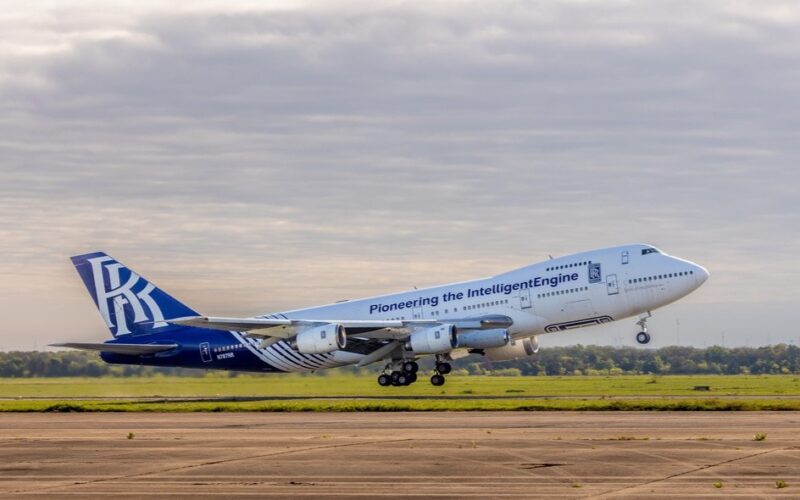
Rolls-Royce reports that the company’s dedicated Boeing 747 flying testbed has seen the successful start of the Pearl 10X, their newest aero engine designed for the business aviation industry.
Dassault, a French aircraft manufacturer, has decided to use this engine only to power their newest flagship, the Falcon 10X. As stated at last year’s Capital Markets Day, the commencement of flight testing represents a significant milestone for both Rolls-Royce and the Pearl 10X programme as the company concentrates on expanding in the business aviation industry.
The first Rolls-Royce engine to power a Dassault business jet is the Pearl 10X, the newest engine in the state-of-the-art Pearl engine family. The Pearl 10X was chosen by the French aircraft manufacturer as their new flagship model, demonstrating even more of Rolls-Royce’s dominance in the business aviation engine market.
Over the next few months, pilots and flight test engineers from Tucson, Arizona, USA, will put the engine through its paces. The flight test programme will comprise testing of the nacelle’s anti-icing system, in-flight relights, engine performance and handling checks at various speeds and altitudes, and fan vibration tests at various altitudes.
The new auxiliary gearbox, which enables higher additional power extraction, and the ultra-low emissions ALM combustor, which is compatible with 100% Sustainable Aviation Fuel (SAF), have undergone extensive testing as part of the ground-based development programme thus far. The engine will be the most potent business aviation engine in the Rolls-Royce lineup. It exceeded its intended thrust levels during the very first test run. With over 2,300 testing hours successfully completed on the Pearl 10X engine configuration as well as the Advance 2 demonstration, the programme is moving forward at a rapid pace.
With the most economical engine core available for business aircraft, the Advance2 engine, coupled with a high-performance low-pressure system, gives the Pearl 10X an exceptional thrust of over 18,000 lbf. With a 5% increase in economy over the previous generation of Rolls-Royce commercial aviation engines, the Pearl 10X

